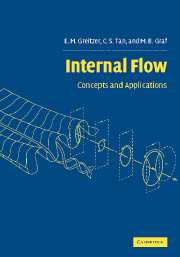Book contents
- Frontmatter
- Contents
- Preface
- Acknowledgements
- Conventions and nomenclature
- 1 Equations of motion
- 2 Some useful basic ideas
- 3 Vorticity and circulation
- 4 Boundary layers and free shear layers
- 5 Loss sources and loss accounting
- 6 Unsteady flow
- 7 Flow in rotating passages
- 8 Swirling flow
- 9 Generation of streamwise vorticity and three-dimensional flow
- 10 Compressible internal flow
- 11 Flow with heat addition
- 12 Non-uniform flow in fluid components
- References
- Supplementary references appearing in figures
- Index
10 - Compressible internal flow
Published online by Cambridge University Press: 14 January 2010
- Frontmatter
- Contents
- Preface
- Acknowledgements
- Conventions and nomenclature
- 1 Equations of motion
- 2 Some useful basic ideas
- 3 Vorticity and circulation
- 4 Boundary layers and free shear layers
- 5 Loss sources and loss accounting
- 6 Unsteady flow
- 7 Flow in rotating passages
- 8 Swirling flow
- 9 Generation of streamwise vorticity and three-dimensional flow
- 10 Compressible internal flow
- 11 Flow with heat addition
- 12 Non-uniform flow in fluid components
- References
- Supplementary references appearing in figures
- Index
Summary
Introduction
Chapters 10 and 11 address flows in which substantial changes in density occur. The changes arise from processes which are dynamical (e.g. density changes from pressure variations associated with fluid accelerations) or thermodynamic (density changes primarily from bulk heat addition due to chemical reaction or phase change) or a combination of the two. This chapter focuses primarily on situations with density variations due to dynamical effects; as we saw in Section 2.2, this means flows with Mach numbers significant compared to unity. Chapter 11 discusses flows with density variations primarily due to heat addition.
Much of the material is based on quasi-one-dimensional gas dynamics. Characterization of quasione- dimensional analysis as “the secret weapon of the internal fluid dynamicist” (Heiser, 1995) is an apt aphorism indeed. This type of treatment enables useful engineering estimates in a wide variety of situations and is a powerful tool for providing insight into the response of compressible flows to alterations in area, addition of mass, momentum, and energy, swirl, and flow non-uniformity. This is true not only for simple duct and channel flows but also for more complex problems, for example those arising in the matching of gas turbine engine components (Kerrebrock, 1992; Cumpsty, 1998).
Many computational techniques now exist to address internal flows in complex geometries. As such, we spend little time in discussion of approximations that were necessary in the past to attack compressible flow problems. One-dimensional analysis, however, is still very much a part of modern approaches to grappling with internal flow problems, even though its use as a detailed design tool has been supplanted by more accurate computations.
- Type
- Chapter
- Information
- Internal FlowConcepts and Applications, pp. 506 - 574Publisher: Cambridge University PressPrint publication year: 2004

